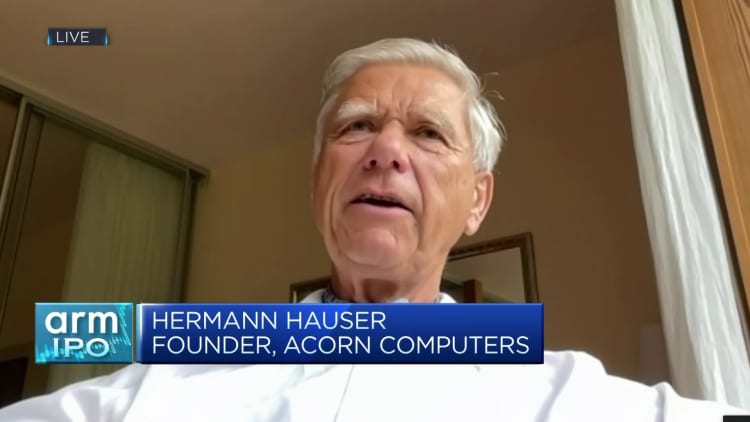With Arm slated to begin buying and selling on the Nasdaq on Thursday, buyers are contemplating the potential upsides — and disadvantages — of investing within the firm.
The British chip designer itself flagged a number of dangers in its IPO prospectus, starting from its China business to geopolitics, however one potential menace has gained traction as its itemizing nears.
It’s known as RISC-V, pronounced “risk five” — a rival chip design that’s backed by a few of Arm’s personal prospects.
While analysts informed CNBC it is not a direct menace, Arm itself warned that if it positive aspects traction, it may pose a aggressive threat.
What is RISC-V?
To perceive RISC-V, let’s contemplate what Arm really does. Arm designs what’s generally known as an instruction set structure (ISA) for chips generally known as processors or central processing items (CPUs). These chips could be regarded as the mind of an digital machine.
Arm’s ISA is successfully the blueprint for processors that different corporations, from Apple to Qualcomm, base their chips on.
Arm expenses these corporations licensing charges to make use of its know-how to construct their very own chips. It additionally will get royalties when these chips are produced and go into finish units. Arm’s designs underpin processors in 99% of the world’s smartphones.

RISC-V, in the meantime, is a completely totally different instruction set structure. RISC stands for lowered instruction set pc.
The primary distinction is that RISC-V is open-source, that means it is free to make use of.
“If RISC-V-related technology continues to be developed and market support for RISC-V increases, our customers may choose to utilize this free, open-source architecture instead of our products,” Arm mentioned in its IPO prospectus.
Is RISC-V gaining traction?
RISC-V lately has gained help from a number of the world’s largest know-how corporations, a lot of that are additionally Arm prospects.
Google, Samsung, Qualcomm and Nvidia, for example, are a part of a consortium fashioned in 2020 to develop RISC-V-based applied sciences.
Arm warned that if this improvement is profitable, there may very well be a viable different to its structure.
“Although the development of alternative architectures and technology is a time-intensive process, if our competitors establish cooperative relationships or consolidate with each other or third parties, such as the recently announced joint venture focused on RISC-V, they may have additional resources that would allow them to more quickly develop architectures and other technology that directly compete with our products,” Arm mentioned in its IPO prospectus.

Support for RISC-V was “galvanized” after Nvidia proposed to purchase Arm for $40 billion in 2020, in line with know-how researcher Richard Windsor, founding father of Radio Free Mobile.
He prompt that different gamers had been nervous that if a serious buyer like Nvidia managed Arm, it may very well be an obstacle to a few of Nvidia’s rivals.
The proposed takeover “raised a lot of hackles in the industry” and a few Arm prospects are “starting to think twice” about their dependency on the corporate, Windsor informed CNBC this week.
“Maybe we should have a second source just in case things start not going in our direction, or we have problems with Arm,” he added, in reference to the pondering amongst some Arm prospects.
Is RISC-V a menace to Arm?
The basic consensus is that, proper now, RISC-V would not pose a serious menace to Arm. That’s as a result of the know-how is at present far inferior to Arm’s providing.
“The issue with RISC-V is it’s much more immature. It doesn’t have the same level of support for more advanced designs,” Peter Richardson, analysis director at Counterpoint Research, informed CNBC.
“RISC-V is quite far away from being at that leading edge, but for some workloads not at the cutting edge, then RISC-V can work quite well.”

One of Arm’s large successes is its big buyer base of main tech gamers. This has allowed Cambridge, England-based firm to construct an “ecosystem” of corporations that depend on its know-how — a bonus that RISC-V would not have.
“Whenever you devise software that runs on one Arm, it will run on all the others as well,” Herman Hauser, founding father of Acorn Computers, the corporate behind the primary Arm chip, informed CNBC’s “Squawk Box Europe” on Thursday. “So I think Arm will continue to retain its dominant position.”
However, there are fears that Chinese corporations specifically may view RISC-V as a less expensive — and extra interesting — different, significantly if Arm will increase its costs.
“If Arm raises its prices, what are chip designers in China going to do? They’re probably going to go for the free version. I wouldn’t be surprised if China really scales up on RISC-V,” Cyrus Mewawalla, head of thematic intelligence at Global Data, informed CNBC this week.
Source: www.cnbc.com

